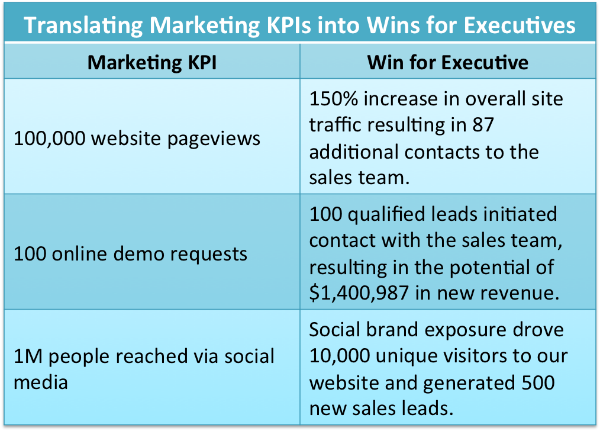
In my role as an Account Manager at a TopRank Marketing, I work directly with brand marketing teams to strategize and execute on digital marketing initiatives for a wide variety of KPIs: website traffic, leads, social engagement, brand awareness, ecommerce sales, etc.
In my earlier agency days, I believed that if we delivered results, on time and on budget, that the data would speak for itself. Executives would see how many pageviews we accrued, or the number of leads from the website and immediately see the value of our work. However, as I became more experienced, I started to understand the necessity of translating success into insights that brand marketing teams could quickly pass up the ladder.
Recent studies have uncovered that CMOs plan to spend upwards of 75% of their budgets on digital marketing in the next five years. Now in order for that investment to be worth it, these activities must have a positive impact on their business. That means, the real value of a marketing strategy goes beyond KPIs.
Executives will always be looking to hear how marketing successes are tied to the company’s overarching strategy and objectives. This is a truth that many of our clients answer to often, and look to TopRank Marketing as a strategic partner to help communicate. Below are three ways marketing professionals can successfully turn marketing successes into wins for their executives.
#1 – Speak the Language of Your Executives
Map marketing KPIs to revenue, sales leads and growth
Marketers find value in metrics such as pageviews and social reach; however, when translating these wins to executives, it’s important to map marketing KPIs to business outcomes that resonate with executives’ objectives related to revenue, sales, leads and growth.
Often, translating marketing KPIs into relevant successes requires a deep dive into your web analytics. At TopRank, this is something we often help our clients with. From tracking website visitor flows through Google Analytics to mapping website inquiries back to CRM data — this type of data can move mountains (marketively-speaking).
Here are a few examples of how to translate marketing KPIs into wins for executives:

For the ultimate reflection of marketing ROI, ensure your reporting infrastructure allows you to follow sales inquiries and leads through sales funnel to attribute actual revenue with digital marketing initiatives. “Easier said than done” you say? You’re not alone. In fact 63% of surveyed business professionals interested in digital marketing did not agree with the statement ‘we have a good infrastructure in place to collect the data we need’.
The first step in conquering digital marketing performance is to discuss with your digital agency what type of tracking capabilities are available, and what it will take to implement and report.
#2 – Know the Lifetime Value of a Customer
Prove ROI and allocate budget effectively by benchmarking CLV
I’ll give you an example of where knowing the lifetime value of a customer is essential in determining the success of a digital marketing program.
A large B2B ecommerce company was testing Google AdWords as a channel to drive ecommerce sales and customer registrations. After a 3 month test, the cost per registration was around $500, but the company had no way of knowing if that was an acceptable number. In order to assess the cost per registration, they needed to know what the average amount of sales each registrant would generate on average, over the lifetime of their registration. As a result of not understanding their CLV, the company struggled to effectively communicate the success or failure of the program to executives.
OMETRIA.com details a few ways to calculate the customer lifetime value in Ecommerce.
#3 – Create a Visual Representation of the Strategy
Make it easy for executives to understand the strategy fueling the initiatives
Executives are busy – generally too busy to read lengthy reports or tabs of Excel sheets in full. Summarize your digital marketing strategy in a visual model (I’m partial to the hub/ spoke and flow chart models for strategy representation). Scientifically, our brains are wired to process visual cues before consuming text, with comprehension and attention to visualizations prioritized over text. As a result, models and other visual representations are the opportune way to quickly and clearly communicate marketing strategies and results to executives.
Bringing it All Full Circle
Ultimately, the best way that a marketing department and an agency can work together to create value for executives is by focusing on strategies and tactics that will help the company achieve top business objectives. In addition to reporting the information in a way that speaks to executives, it’s also important for these teams to adapt their approach when needed to maintain alignment with company goals.
See how TopRank Marketing helped one company reduce their average cost per lead by 69%.
Header image via Shutterstock


